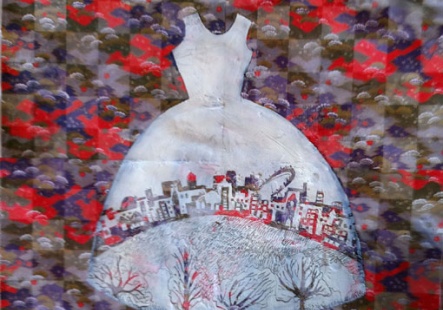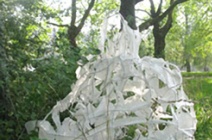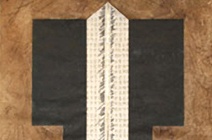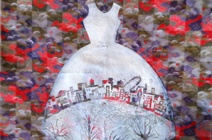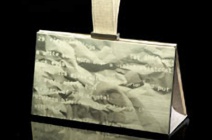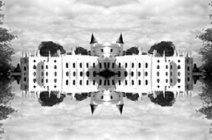To Wear?
To Wear?
Gabriella Ingram, Gemma Land, Lynn Denison, Pip Culbert, Priscilla Purcell
In To Wear?, fashion, style and art are inextricably linked in works that defy the boundaries of sculpture and clothing. The show features unique and extraordinary works ranging from luxurious paper kimonos and a dress embroidered with insects to deconstructed garments or silk scarves and handbags made from highly polished etching plates.
The viewer is invited to experience works of art which have become or been inspired by different garments. Each work is made of beautiful materials which are not conventional to the fashion world. In stark contrast to the rapid production rates in the fashion industry, every piece in To Wear? emanates a sense of timelessness and outstanding quality.
Priscilla Purcell’s works resonate with colour and evoke a myriad of different countries and cultures, from Turkish turquoise to Mayan gold. She uses materials as diverse as inks and gold leaf, to polyfiller in her large sculptural pieces and works on paper. Powerful and striking, a life size paper kimono draws together Priscilla’s skills in papermaking, textiles and embroidery as well as her experiences travelling to remote areas where paper is made symbiotically alongside fabrics. In Prisicilla’s series of ceremonial robes she explores how design and art can intensify a sense of great power and influence. The pieces are based on the shape and proportion the Japanese Kimono, here adorning the walls of the gallery. Priscilla draws her inspiration and materials from her personal and professional experiences; travel throughout Asia, Africa and the Americas is reflected in her work and the varied textures, as is the Tarot, Haiku poetry, the significance of symbol, colour and number in different cultures. In a contrast of scale, the smaller two dimensional works also included in the exhibition hang unframed, allowing the viewer to engage with the materials and deep, rich colours.
Lynn Denison explores the decorative, symbolic and emotional qualities of clothing and its powers to attract, disguise and defend. Lynn’s paper sculptures are inspired by personal memories as well as more universal experiences of fate, fortune and change. The shapes of the dresses themselves evoke Velazquez’s Meninas; the stiff white paper stands proud, but empty, leaving the viewer to imagine the person within. Through these dresses and her works on paper, Lynn’s work is immersed in the surreal and the fantastical. Moody and evocative painted landscapes stretch across the hem of another dress. These timeless landscapes represent how personal experiences become part of the fabric of family memories and traditions. In a more macabre work, Lynn has meticulously stitched dead wasps onto a dress. Lynn is a true tailor of fairytales.
Gabriella Ingram has created a stunning series of evening bags, which are made from metal etching plates and taffeta. The highly polished nickel, silver or copper metals exude rich, luxurious colours, which are bent around the black fabric. However it is the detailed imagery of these plates which make these pieces so unusual The imagery is derived from a variety of sources including 17th and 18th century lace, Rococco tables, Chinese poetry, antique chandeliers amongst others. While Gabriella’s inspiration is rooted in an in depth understanding of the history of art and design, her bags have a contemporary twist. The engraved metal gives an exhilarating luminescence when it catches the light, emphasising the contrast between the fine detail and shadows in the cut metal. These elegant and striking handbags are from a limited edition made in London and Berlin.
Following her residency at Strawberry Hill, Horace Walpole’s recently restored Gothic castle in Richmond, Gemma Land has created a limited scarf and photographic print edition for this exhibition. The images from her time at Strawberry Hill have been reflected and replicated to abstract the images of this unusual house, bringing the images to a point of abstraction. These images have been digitally printed onto large high quality silk scarves with hand rolled edges. This abstraction is proliferated when the scarf is worn; in the folds and drapery of the fabric, the viewer looks past the depicted structures into the shadows and details of the building within the scarf. Gemma’s unique style fuses her photographic practice with a wearable artwork. Her experiments with architecture and symmetry create impossible structures and hallucinogenic patterns. Her aesthetic lies between the Romantic and the Gothic, creating beautiful and often somewhat unsettling imagery.
Pip Culbert reduces the soft and comforting fabrics of our familiar life to their constitute skeletal structure. In each work, the fabric of each garment or object is removed to leave only the hems and seams. Where the panels of fabric are removed, what remains is the stitching, once upon a time stitched by hand, now finished by machine. These evoke lines, even boarders of countries, with relatively vast empty spaces between them. Once soft garments are translated into minimalist, geometrical structures, straddling the boundaries between two and three-dimensional works. Pip’s work emerges as stitched reliefs which relate to folk traditions. Shirts, dresses, handkerchiefs, pockets are deconstructed, brought down to their seams; the remnants assume ghostly silhouettes and the spacesbecome more evocative than their parts.
The work in this unique exhibition not only challenge perceptions about the relationship between art and clothing, but has distinctly contemporary and international flavour.

